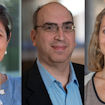
Sung Han’s laboratory focuses on understanding the neural circuitry and neural peptides within the sensory system that respond to threatening situations. Sensory hypersensitivities — resulting in inappropriate triggering of this threat response — have been linked to a variety of neurodevelopmental and psychiatric disorders, including autism spectrum disorders (ASD).
In November 2015, while Han was a senior fellow researching threat circuits in the laboratory of Richard Palmiter at the University of Washington, he was selected as a finalist for a SFARI Bridge to Independence Award. SFARI established the Bridge to Independence Award program with the goal of investing in the next generation of top autism investigators, providing funds to help senior postdoctoral scientists transition from mentored training positions to independent faculty positions.
Now an assistant professor at the Clayton Foundation Laboratories for Peptide Biology at the Salk Institute, Han is using his Bridge to Independence Award to identify neural circuits that encode aversive sensory signals and, subsequently, to address whether neurons in these circuits are more sensitive to sensory stimuli in animal models of ASD.
I recently spoke with Sung Han about the work his laboratory is doing and how the Bridge to Independence Award aided his transition to an independent faculty position. The interview has been edited for clarity and brevity.
You first focused on autism research while working as a Ph.D. student in Bill Catterall’s laboratory at the University of Washington. Can you tell us a bit about that earlier work?
During my Ph.D. in the Catterall lab, I studied ion channels. Bill Catterall is one of the pioneers who identified, cloned and purified ion channels, including voltage-gated sodium and calcium channels. When I joined his lab, I was involved in a systems-level project using a mouse model, to see how dysfunction of ion channels can cause behavioral changes. What I found is that loss of a brain-specific voltage-gated sodium channel named SCN1A leads to social interaction deficits and stereotyped behaviors in mice1. At the same time, an independent research group performed a human genetics study and showed that de novo mutations in the SCN1A gene were associated with increased risk for ASD2. This showed that the SCN1A knockout mouse had construct validity as a genetic mouse model of ASD.
I also found an increase in the excitation/inhibition (E/I) ratio in the SCN1A knockout mouse, which is one of the mechanisms that has been linked to ASD pathogenesis. We showed that this leads to the behavioral deficits in the mouse model because I could rescue the behavior by rebalancing the E/I ratio. The way I did this was that I treated the mice with clonazepam, a benzodiazepine that increases inhibitory interneuron activity. Benzodiazepines are used clinically for a variety of indications, including seizures, anxiety disorders and insomnia, due to their anticonvulsant, anxiolytic and sedative actions. In these experiments, I reduced the dose of the benzodiazepine until I didn’t see any sedative effects. At this low dose, I was able to rescue the social interaction deficits and repetitive behaviors, as well as other behavioral phenotypes associated with ASD.
In a second paper, I tested this low-dose benzodiazepine treatment on the BTBR mouse, another mouse model of ASD, and it also worked to rescue behavioral deficits in that model3. That provides strong evidence in support of the hypothesis that an E/I ratio imbalance leads to ASD. It also suggested that behavioral impairments in ASD may be able to be reversed if the E/I ratio could be rebalanced.
“I think that [the Bridge to Independence Award] is definitely helpful for securing a tenure-track faculty position.”
You then went on to become a postdoctoral senior fellow with Richard Palmiter. Why did you make that move?
The reason I chose the Palmiter lab is that I realized that understanding neural circuitry is really important for understanding ASD pathogenesis. This is because a large number of ASD risk mutations contribute to synaptic dysfunction. So I wanted to study autism in the context of the neural circuit, and Richard Palmiter’s lab is well-known for their work on neural circuits. In Richard’s lab, I didn’t study autism though. I studied the neural circuit that transmits pain information during aversive learning. I wanted to learn different approaches to studying neural circuits, in order to be able to pursue ASD research in my independent career.
So we know that the amygdala in the brain is important for aversive learning. But we didn’t know how the aversive sensory cue arises in the amygdala. People thought that the thalamus might have a role but there was some controversy. In my research, I focused on the brainstem, which is a primitive area of the brain conserved throughout reptiles, fish and mammals and known for key survival functions. I found that the brainstem also relays the pain information from the spinal cord to the amygdala during aversive learning4. After I published those findings, I started to look for a position and I finally got a job.
You were one of the first awardees of SFARI’s Bridge to Independence Award program. Do you think that this award helped distinguish you from other candidates during your search for a faculty position?
For sure. I feel really lucky that I received this award. It’s getting harder and harder to get tenure-track positions these days because lots of people are trying to get a job, and faculty position job openings are very limited. So, competition-wise, it’s very hard to get a job. For many reasons, I think it’s really important to have funds like the SFARI Bridge to Independence Award.
The first reason is that I’m bringing money to the department — nobody will dislike that! And the second, which I think is even more important, is that it shows to the research committee that I am independent enough to write, to design and to develop my own research program — and it suggests I can secure funds in the future. So I think it’s really helpful. When I talked to the research committees and faculty members during the interview process, a lot of people mentioned the award. So I think that it’s definitely helpful for securing a tenure-track faculty position.
What challenges have you faced in setting up your own laboratory, and how has your SFARI funding helped in this transition?
It’s hard to get a faculty job. But its been even harder setting up the lab, because I’ve never done this before. When I was a trainee and a postdoc, I just needed to focus on the research. But now I need to focus on research as well as other things like administration, hiring and managing people, and securing funds.
The SFARI funding has been really helpful in getting things started. In my lab, I have three people right now — one graduate student, one postdoc and one technician. Even though setting up a lab has been really challenging for me, I think I’m going in the right direction.
“Many people in the autism field study sensory hypersensitivity involving cortical areas, but few labs are studying sensory hypersensitivity in subcortical structures.”
What areas of autism research are you most excited to start tackling in your own lab?
In the Palmiter lab, I studied painful aversive learning. That’s different from ASD, but I think it’s related, and I’ll tell you why. In aversive learning, if you touch a hot coffee mug, you realize that it’s really hot. You learn that it’s hot. So the next time you grab the hot coffee mug, you take extra care before you touch it. That is aversive learning, and the paper that I published in Cell in 20154 showed a role for the brainstem in aversive learning.
In my own lab, my main interest is on how our brains perceive this aversive sensory cue as a threat. Appropriate sensor perception is critical for survival. But sometimes the brain’s alarm system can malfunction and we experience a false alarm. I think autism is like that. Individuals with autism may recognize normal sensory signals as aversive ones, so that may lead to behaviors like social deficits and repetitive behaviors. Actually, most individuals with ASD are very sensitive to at least one form of sensory cue like visual or auditory, touch or tactile responses, even sometimes olfactory and gustatory. And many are very picky eaters. So I think these behaviors fit with my hypothesis — that somehow individuals with ASD perceive otherwise normal sensory information as aversive, and that can cause some of the behavioral phenotypes associated with ASD.

Sung Han Laboratory/Salk Institute
Neurons in the parabrachial nucleus of the brainstem, the cells that relay aversive sensory information to the amygdala, are labeled in green. These are the neurons that Han hypothesizes may be hyperactive in ASD, causing normal sensory stimuli to be encoded as aversive.
So I’m trying to focus on that hypothesis by studying neural circuits involved in aversive sensory learning and the brainstem’s role. Many people in the autism field study sensory hypersensitivity involving cortical areas, but few labs are studying sensory hypersensitivity in subcortical structures. I think that subcortical structures that relay or gate sensory information are also important for sensory hypersensitivity in ASD.
What I’m thinking is that genetic mutations associated with autism risk may leave this brainstem area more excitable. So then it sends exaggerated sensory information to cortical brain areas in individuals with ASD. So I’m going to study that [in mice]. I’m going to monitor the neuronal activity of that brain area and then manipulate its neural activity to see if there is a causal relationship with certain behaviors associated with ASD. I’m also going to map the anatomical connections of this area with other brain areas in mouse models of autism.
Looking back on the last few years of your career, what advice would you give to fellows considering applying for a Bridge to Independence Award and to award finalists currently on the job hunt?
I really think that I’m lucky. When I joined the Ph.D. program [in the Catterall lab], the mutant mouse was already available to study. I just used that mouse and I didn’t spend much time generating resources. And in Richard’s lab too — when I got there, all the tools were ready and I just tested my ideas with those established tools. I feel fortunate.
I’m still struggling [to set up my own lab], but I have one piece of advice for others who are actively searching for a job: stay positive and try again and again to increase the probability of getting the position that perfectly fits you. Also, I just applied to a lot of places, but I found that most of the places that I got a response from were ones where the job posting really fit what I’m now doing. So focus on applying to places where it fits your research plan.
Finally, you’ve said setting up a lab can be a struggle. What helps to keep you going?
Yes. I’ve been struggling with setting up the lab, as I mentioned. But one thing that makes me really encouraged is the fact that my research has translational implications. For instance, my Ph.D. work based on a low-dose benzodiazepine treatment has currently only been tested in mouse models of ASD1,3 but benzodiazepines have been on the market for [the treatment of] epilepsy and anxiety disorders for decades. So it would be interesting to see if such a treatment was beneficial for individuals with autism, or at least for a subgroup who exhibit imbalances in E/I balance. The potential for my research findings to help people with ASD is really encouraging and motivates me a lot.


